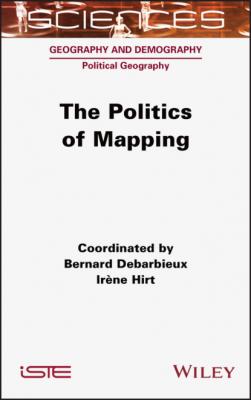The Politics of Mapping. Bernard Debarbieux
Чтение книги онлайн.
Читать онлайн книгу The Politics of Mapping - Bernard Debarbieux страница 20
 including citizens, are responsible, and inhabitation, which society implements.
including citizens, are responsible, and inhabitation, which society implements.
The relations between maps and politics are multiple. In this chapter, the themes of geopolitical propaganda, spatial ideologies, electoral geography, urban planning and citizen democracy show the multiplicity of the subject. In all cases, they raise the question of the specific role of the cartographer, whether they are a technician or a researcher. They must define their own place as a producer of knowledge without taking the place of citizens. This distinction in turn opens up a debate common to all on the ethics of knowledge and communication. The cartographer is not only someone through whom information passes, they are also the one who produces and disseminates it, which places on their shoulders, a responsibility commensurate with the questions and answers of which the act of drawing a map is an integral part. The cartographer’s contribution may sometimes seem modest, but it should never be underestimated because it is a part of the long chain of production, interpretation and action, of which the map is an increasingly present link.
While reinforcing the specificity and richness of its language, cartography has become established in the political scene and now plays a major role in the emergence and dynamics of its issues. A new, more open and more demanding age is therefore upon us.
1.7. References
Barker, R.G. (1968). Ecological Psychology: Concepts and Methods for Studying the Environment of Human Behavior. Stanford University Press, Stanford.
Bénit-Gbaffou, C. (2005). Politique des transports collectifs et démocratie locale à Los Angeles : entre participation et fragmentation. Flux, 2, 6–22.
Bénit-Gbaffou, C., Fol, S., Pflieger, G. (2007). Le front anti-métro en Californie. Controverses autour des politiques de transport en commun. L’Espace geographique, 36(2), 115–130.
Calbérac, Y., Lazzarotti, O., Lévy, J., Lussault, M. (2019). Carte d’identités. L’espace au singulier. Hermann, Paris.
Chavinier, E. and Lévy, J. (2009). Minarets : malaise dans l’alteridentité. EspacesTemps.net [Online]. Available at: https://www.espacestemps.net/articles/minarets-malaise-dans-alteridentite.
Collignon, B. (2002). Les toponymes inuit, mémoire du territoire. Étude de l’histoire des Inuinnait. Anthropologie et Sociétés, 26(2–3), 45–69.
Debarbieux, B. (2015). L’espace de l’imaginaire. Essais et détours. Éditions du CNRS, Paris.
Desbiens, C., Rivard, É., Hirt, I. (2017). Nous nous souvenons du territoire : la géographie québécoise face aux mémoires autochtones. Cahiers de géographie du Québec, 61(173), 293–313.
Elden, S. (2013). The Birth of Territory. University of Chicago Press, Chicago.
Ferry, J. M. (1991). Les puissances de l’expérience : le sujet et le verbe. Le Cerf, Paris.
Foucault, M. (1977). Vérité et pouvoir : entretien avec Fontana, M. L’Arc, 70, 16–26.
Frelat-Kahn, B. and Lazzarotti, O. (2012). Habiter : vers un nouveau concept. Armand Colin, Paris.
Gibson, J.J. (1977). The theory of affordances. In Perceiving, Acting, and Knowing: Toward an Ecological Psychology, Shaw, R. and Bransford, J. (eds). Lawrence Erlbaum Associates Inc, Hillsdale.
Harley, B. and Woodward, D. (1987–2015). The History of Cartography. Chicago University Press, Chicago.
Harvey, D. (1969). Explanation in Geography. Edward Arnold, London.
Harvey, D. (1973). Social Justice and the City. Edward Arnold, London.
Hirt, I. (2012). Mapping dreams/dreaming maps: Bridging Indigenous and Western geographical knowledge. Cartographica, 47(2), 105–120.
Kant, E. (1785). Fondements de la métaphysique des mœurs [Online]. Available at: http://classiques.uqac.ca/classiques/kant_emmanuel/fondements_meta_moeurs/fondements.html.
Kant, E. (1798). Le conflit des facultés. In Opuscules sur l’histoire. Garnier-Flammarion, Paris.
Koseki, S.A., Lévy, J., Sartoretti, I. (2020). De l’espace pour l’école de la réussite. Zenodo [Online]. Available at: http://doi.org/10.5281/zenodo.3773955.
Lazzarotti, O. (2006). Habiter, la condition géographique. Belin, Paris.
Lévy, J. (1994). L’espace légitime. Presses de Sciences Po, Paris.
Lévy, J. (2014). Science + space + society: Urbanity and the risk of methodological communalism in social sciences of space. Geographica Helvetica, 69(2), 99–114.
Lévy, J. (ed.) (2015). A Cartographic Turn: Mapping and the Spatial Challenge in Social Sciences. EPFL Press, Lausanne.
Lévy, J. (2020). Ce dont on peut parler, il faut le dire. EspacesTemps.net [Online]. Available at: https://www.espacestemps.net/articles/ce-dont-on-peut-parler-il-faut-le-dire.
Lévy, J. and Chavinier, E. (2009). Malaise dans l’alteridentité. EspacesTemps.net [Online]. Available at: https://www.espacestemps.net/articles/minarets-malaise-dans-alteridentite/.
Lévy, J. and Sartoretti, I. (2018). Arts et sciences : le temps de l’hybridation. EspacesTemps.net [Online]. Available at: https://www.espacestemps.net/articles/arts-sciences-le-temps-de-lhybridation/.
Lévy, J., Poncet, P., Tricoire, E. (2004). La carte, enjeu contemporain. La Documentation française, Paris.
Lévy, J., Maitre, O., Pôvoas, A., Fauchille, J-N. (2017). Atlas politique de la France. Les révolutions silencieuses de la société française. Éditions Autrement, Paris.
Lévy, J., Fauchille, J-N., Pôvoas, A. (2018). Théorie de la justice spatiale. Géographies du juste et de l’injuste. Odile Jacob, Paris.
Lévy, J., Piantoni, S., Pôvoas, A., Renaud, E., Richelle, J., Schmitt, G. (2020). Topologies politiques. Espace politique et dynamique sociale après l’élection présidentielle américaine de 2020. EspacesTemps.net [Online]. Available at: https://www.espacestemps.net/articles/topologies-politiques/.
Monmonier, M. (2019). Comment faire mentir les cartes. Éditions Autrement, Paris [Original published 1991].
Raffestin, C., Lopreno, D., Pasteur, Y.